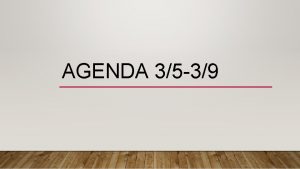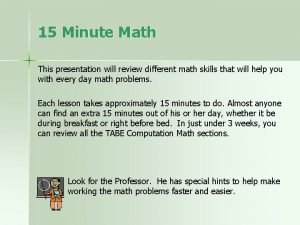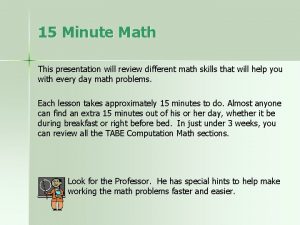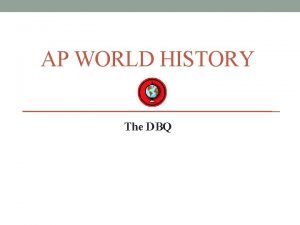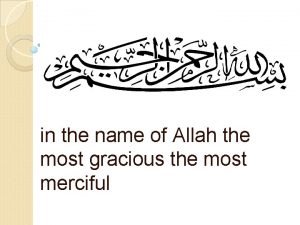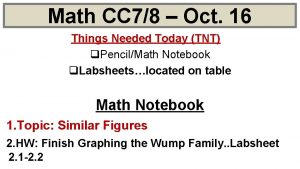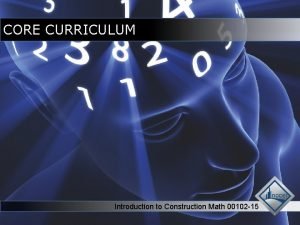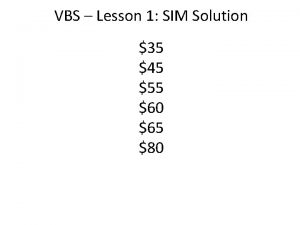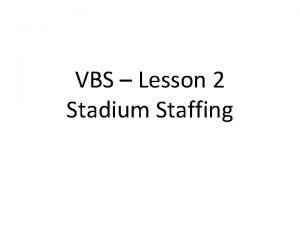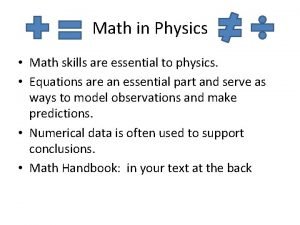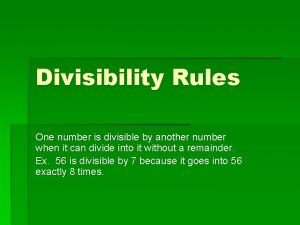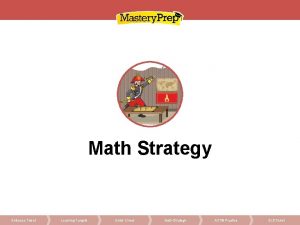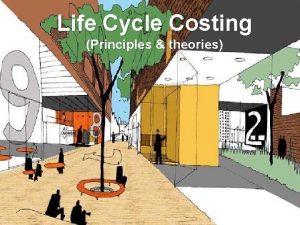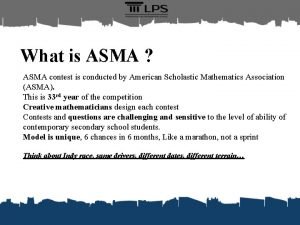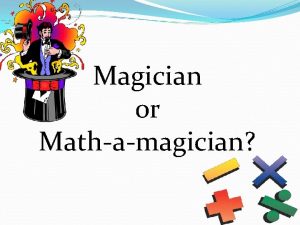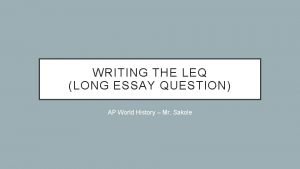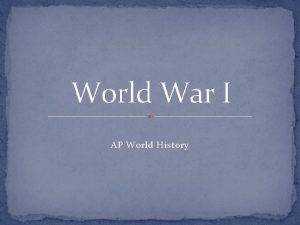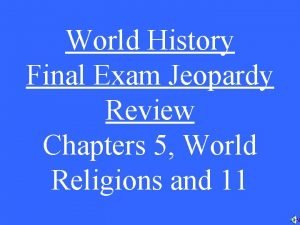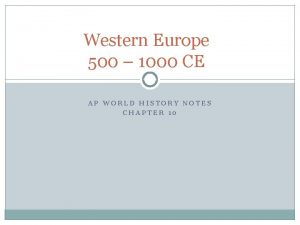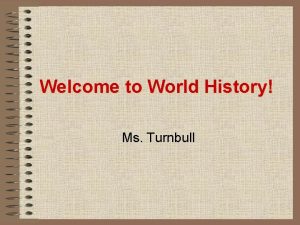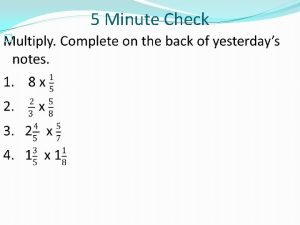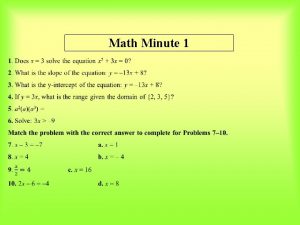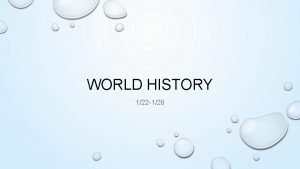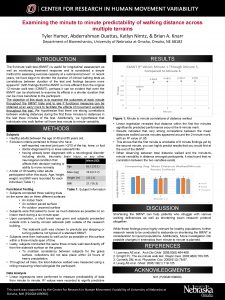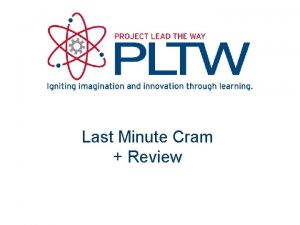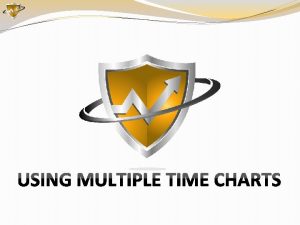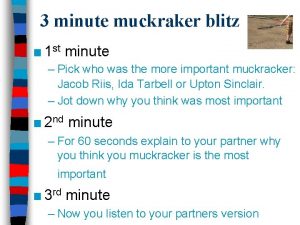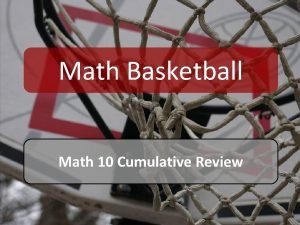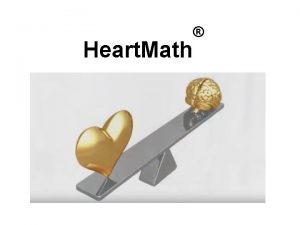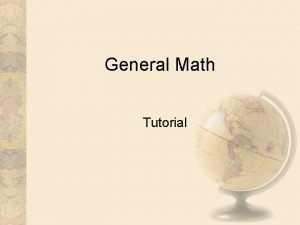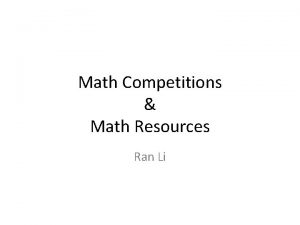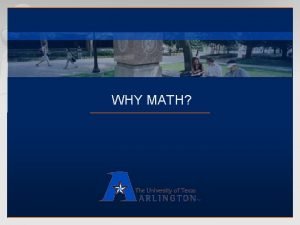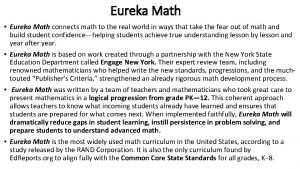WORLD HISTORY 25 29 Math Minute 25 Answers


































- Slides: 34

WORLD HISTORY 2/5 -2/9

Math Minute 2/5 Answers

LEADERS DURING WW II ACTIVITY/GALLERY WALK • For your assigned Leaders you will look up the following information for your notebook and chart. 1. Country they represented in WWII: 2. Axis or Allied: 3. Position/Title during WWII: 4. Major War Contributions/Significance: (can be negative) 5. Date of Death: 6. Interesting Fact:

LEADERS DURING WW II ACTIVITY/GALLERY WALK 1. Winston Churchill 2. Franklin Delano Roosevelt 3. Emperor Hirohito 4. Hideki Tojo, 5. Adolf Hitler 6. Benito Mussolini 7. Joseph Stalin 8. Harry Truman 9. Douglas Mac. Arthur 10. Dwight Eisenhower

EXIT TICKET 1. Based on the map and your prior knowledge, what caused the Germans to cut through Belgium in rout to France? (EQ 48) A. The large ocean that divides France and Germany. B. The construction of Maginot Line. C. The Appalachian Mountains. D. Fear the French would hear them coming if they tried to attack head on.

EXIT TICKET 2. The United States’ experience during WW 2 was far different than that of the other Allied countries for what reason? (EQ 48) A. Most of the fighting took place in the U. S. B. The U. S. was producing most of the war materials. C. The lives of the U. S. citizens were not disrupted by the war. D. Women were involved in the military.

AGENDA/ESSENTIAL QUESTIONS • ACT Bell. Work • Present—Fill in Notes—Leaders during WW II • Note—End of the War • EQ-49 How can one describe the contributions and roles of leaders during the war, including Winston Churchill, Franklin Delano Roosevelt, Emperor Hirohito, Hideki Tojo, Adolf Hitler, Benito Mussolini, Joseph Stalin, Harry Truman, Douglas Mac. Arthur, and Dwight Eisenhower? • • EQ-47 What nations comprised of and where were the Allied and Axis powers located? How can one explain the major battles of the Pacific and European theaters of war including blitzkrieg, Dunkirk, Battle of Britain, Stalingrad, Normandy, Midway, Battle of the Bulge, Iwo Jima, and island hopping? (CCRL-9) • EQ-52 What were the casualties of war with specific regard to the civilian and military losses in Russia, Germany, Britain, the United States, China, and Japan?

Question 1 A lot of people hate to ride the New York City subways, but I love them because I like to get places fast. A musician balancing cello case, two Buddhist monks in saffron robes, and group of stockbrokers. Answer A. NO CHANGE!! B. I never know what I’ll see there. C. They are so much cheaper than taxis. D. They are places of enormous quiet and calm.

Question 2 The total cost of renting a car is $30. 00 for each day the car is rented plus 28. 50 cents for each mile the car is driven. What is the total cost of renting the car for 5 days and driving 350 miles? Answer A. $ 104. 75 B. $159. 98 C. $249. 75 D. $ 1, 147. 50

Question 3 Last week some fellow passengers and I watched an elderly man with a portable chessboard playing chess against himself. Which of the following alternatives to the underlined portion would NOT be acceptable? Answer A. who played B. as he played C. played D. who was playing

Question 4 In a bag of 400 jelly beans, 25% of the jelly beans are red in color. If you randomly pick a jelly bean from the bag, what is the probability, that the jelly bean picked is NOT one of the red jelly beans? Answer A. 1/2 B. 1/4 C. 1/16 D. 3/4

Question 5 Which of the following is not in the insect family? Answer A. mosquito B. bee C. spider D. bristletail

Answers Answer 1. A 2. C 3. C 4. D 5. C

AGENDA/ESSENTIAL QUESTIONS • BW—Need to Know • • PPT/Notes—What you need for the EQ Quiz EQ-52 What were the casualties of war with specific regard to the civilian and military losses in Russia, Germany, Britain, the United States, China, and Japan? • EQ-50 What was the impact of the Holocaust on the Jewish populations in Europe and Israel? (CCRL-9) • EQ-51 How can one analyze the decision to use nuclear weapons to end World War II? • EQ-53 What were the goals, leadership, and postwar plans of the principal allied leaders: the Atlantic Conference, Yalta, and the Potsdam Conference using text evidence? • EQ-55 What was the nature of reconstruction in Europe after 1945, including the purpose of the Marshall Plan, creation of NATO, and division of Germany? •

Need to Know 2/6/18 1. Based on the photo and your prior knowledge, how did Hitler use propaganda to persuade the German people against European Jews? (EQ 50) A. ) Posters throughout Germany portrayed them as monsters and the main cause of Germany’s demise. B. ) He wanted to show German that the Jews were kind people. C. ) He left the German people to make their own assumptions about the Jewish. D. ) He did not want to blame the Jews. 2. Based on the chart and your prior knowledge, which group was Hitler attempting to eradicate? (EQ 50) 3. Why do you think the Holocaust had such a lasting impact on the people of the world?

END OF THE WAR AND THE HOLOCAUST • *By 1943 the tide of the war had turned against the Axis Powers and the Allies now had the advantage.

EUROPE • Allied forces attack in Northern Africa and then through Italy surrendered June 4, 1944 • All the while the Allies were planning an invasion of France but had to overcome many obstacles—both physical and military. • Had to attack on beaches so had to develop landing craft that would work • Had to overcome German defenses including—underwater mines, barbed wire, landmines, mine-tipped underwater anti-landing craft mines, fortified bunkers with heavy machine guns. • D-Day June 6, 1944 allies land 2 million troops in France by August had liberated Paris. • Battle of the Bulge—last German offensive • May 7 th 1945 --surrounded by Allied Powers on the east and West—Germany surrenders


PACIFIC • War in the Pacific continued after the Axis surrendered in Europe. • Allies continue to use Island Hopping to get to Japan • Battle of Iwo Jima and Okinawa • Iwo Jima--Important to stop Japanese Air war. Allies felt it would lessen the threat on Allied ships to stop the Japanese Air Assaults • Okinawa—Allies needed this island as a base as they got closer to Japan. • Both battles came at a great cost of lives for the Allies

• Atomic Bombs—US had developed new weapons—Atomic Bombs. Truman had to decided if it was worth attacking Japan— risking possibly millions of American lives— or use the bombs—with all of its unknowns —Decided to drop bombs • Hiroshima— 1 st bomb— 190, 000 people died due to the blast and later radiation poisoning. • Nagasaki— 3 days later • Japanese surrendered August 14, 1945

. Based on the quote and your prior knowledge, what can you infer about the decision to drop the Atomic Bomb? (EQ 51) a. Truman had no trouble in dropping the bomb. b. It was a tough decision, but Truman felt it had to be done to end the war. c. He never wanted to drop the bomb. d. Truman decided to not drop the bomb.

By Oberiko at English Wikipedia, CC BY-SA 3. 0, https: //commons. wikimedia. org/w/index. php? curid=2099196

HOLOCAUST • Know in Germany as the Final Solution it was Germany’s attempt to eradicate the Jewish and other undesirable people in Europe. • 1 st Wave—law against Jews in Germany and use of Propaganda to make them seem like villains. • 2 nd Wave—Starvations, migration, killing squads a. Move Jewish people into walled areas of the cities (Ghettos) to separate and starve them to death b. Concentration/Labor camps—using people as slave labor until they die c. Einsatzgruppen—mobile killing squads that followed the military into Russia

HOLOCAUST • 3 rd Wave—Final Solution— EXTERMINATION CAMPS • Jewish people from all around Europe were sent to Extermination Camps where they were gassed immediately on arrival.


HOLOCAUST DEATH— 6 MILLION JEWS AND 910 MILLION OTHERS.

Which of the following was not a step leading to the Holocaust? (EQ 50) • Mobile killing units that went through Poland Russia. • Labor camps to use Jews for the war effort. • Death camps to eliminate the Jews. • Using of Jews as foot soldiers.

HOLOCAUST • After the War the Jewish population of Europe decreased dramatically. • 1. Due to the deaths of the Holocaust • 2. Due to migration including to Israel where they were promised a homeland

ALLIED WAR CONFERENCES • The allied leaders met multiple times to discuss the war plans but also for what would happen after the War 1. Atlantic Charter—post war plan including self-determination for countries. 2. Yalta Conference—decision to demand Germany surrender unconditionally and how to deal with Germany after the War—divided Europe in to 2 zones of influence 3. Potsdam Conference-US demands free elections in Eastern Europe—but know Stalin may not actually allow for that. –beginning of the Cold War.

• Who are the 3 leaders pictured that met at Yalta to discuss what would happen after WWII?

GERMANY DIVIDED • After the war Germany was divided into 4 zones of occupation—help by the allies. As the Cold War grew the Soviets blocked supplies into Berlin. The US Airlifted supplies to break the blockade.

POST WAR RECOVERY • After the war plans to help in the recovery of Europe and to try to gain world peace were attempted. 1. The United Nations---an organization like the League of Nation. A place for nations to discuss and negotiate before going to war 2. The Marshall Plan—US economic aid to the countries of Europe to rebuild after the war—Millions of $$$ to countries who asked 3. NATO/WARSAW PACT—Cold War divisions become more apparent. NATO— US and its allies agree to defend each other if attacked—WARSAW Pact— Soviets answer to NATO

THE COLD WAR DEVELOPS

POSTWAR JAPAN • The US dictated the terms of Japanese surrender. Completely changing their government but allowing them to keep their Emperor. • Due to the growing conflict with the Soviet Union and China becoming communist the US aided in Japan’s economic recovery to keep them from falling to Communism.
 Math minute answers
Math minute answers 1 minutes seconds
1 minutes seconds 15 minute maths
15 minute maths 15 minute math
15 minute math Ap world history chapter 25 africa and the atlantic world
Ap world history chapter 25 africa and the atlantic world Dangerous world tour
Dangerous world tour World history spring final exam review answers
World history spring final exam review answers Ap world dbq 2018
Ap world dbq 2018 World history 1st semester final review answers
World history 1st semester final review answers World history semester 1 exam review
World history semester 1 exam review Chemistry fall semester exam review answers
Chemistry fall semester exam review answers In the name of allah the most gracious
In the name of allah the most gracious Math game math hit the button
Math game math hit the button Wumps math activity answers
Wumps math activity answers Introduction to construction math
Introduction to construction math Parking sim answers
Parking sim answers Kitchen math workbook learning zone express answers
Kitchen math workbook learning zone express answers Stadium staffing
Stadium staffing Convert 5021 cm to kilometers
Convert 5021 cm to kilometers Divisibility rule of 9 with example
Divisibility rule of 9 with example Photomath portal
Photomath portal Annuity math questions and answers pdf
Annuity math questions and answers pdf Asma math contest sample questions
Asma math contest sample questions Magic math tricks
Magic math tricks Also history physical
Also history physical Leq examples ap world
Leq examples ap world Total war world history definition
Total war world history definition Chapter 17 section 3 luther leads the reformation
Chapter 17 section 3 luther leads the reformation Ap world history jeopardy
Ap world history jeopardy Chapter 32 assessment world history
Chapter 32 assessment world history Chapter 30 section 2 world history
Chapter 30 section 2 world history Chapter 15 section 1 world history
Chapter 15 section 1 world history World history final exam study guide
World history final exam study guide Manorial system ap world history
Manorial system ap world history Ms turnbull world history
Ms turnbull world history
